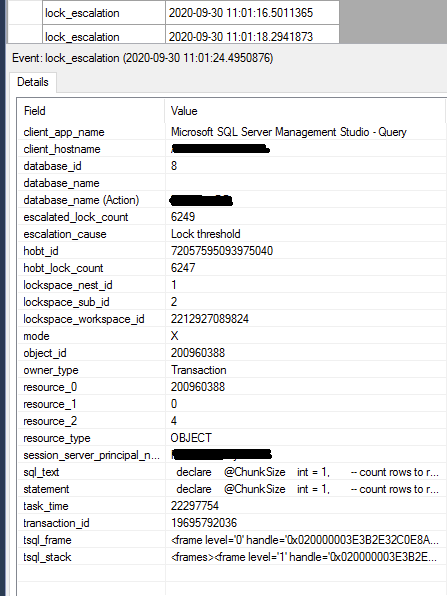How to avoid Table Lock Escalation?
7
votes
1
answer
2144
views
I've got a task to update 5 million rows in a production table, without locking down the whole table for extended time
So, I used approach that helped me before many times - updating top (N) rows at a time with 1-N second interval between chunks
This time started with update top (1000) rows at a time, monitoring the Extended Events session for  Code :
Code :
lock_escalation events in the process
lock_escalation showed up during each update operation, so I started lowering row count per chunk 1000 -> 500 -> 200 -> 100 -> 50 rows and so on down to 1
Before (not with this table, and for delete operations - not update), lowering row count to 200 or 100, helped to get rid of lock_escalation events
But this time, even with 1 row per 1 update operation, table lock_escalation still shows up. Duration of each update operation is about the same, regardless if its 1 row or 1000 rows at a time
How to get rid of table lock escalations in my case ?
@@TRANCOUNT is zero
Extended event:
 Code :
Code :
set nocount on
declare
@ChunkSize int = 1000, -- count rows to remove in 1 chunk
@TimeBetweenChunks char(8) = '00:00:01', -- interval between chunks
@Start datetime,
@End datetime,
@Diff int,
@MessageText varchar(500),
@counter int = 1,
@RowCount int = 1,
@TotalRowsToUpdate bigint,
@TotalRowsLeft bigint
-- total row count to update
set @TotalRowsToUpdate = (select count(*)
from [Table1]
join [Table2] on
btid = tBtID
where btStatusID = 81)
set @TotalRowsLeft = @TotalRowsToUpdate
set @MessageText = 'Total Rows to Update = ' + cast(@TotalRowsLeft as varchar) raiserror (@MessageText,0,1) with nowait
print ''
-- begin cycle
while @RowCount > 0 begin
set @Start = getdate()
-- update packages
update top (@ChunkSize) bti
set btstatusid = 154,
btType = 1
from [Table1] bti
join [Table2] on
btid = tBtID
where btStatusID = 81
set @RowCount = @@ROWCOUNT
-- measure time
set @End = getdate()
set @Diff = datediff(ms,@Start,@End)
set @TotalRowsLeft = @TotalRowsLeft - @RowCount
set @MessageText = cast(@counter as varchar) + ' - Updated ' + cast(@RowCount as varchar) + ' rows in ' + cast(@Diff as varchar) + ' milliseconds - total ' + cast(@TotalRowsLeft as varchar) + ' rows left...'
-- print progress message
raiserror (@MessageText,0,1) with nowait
set @counter += 1
WAITFOR DELAY @TimeBetweenChunks
end
Asked by Aleksey Vitsko
(6195 rep)
Sep 30, 2020, 11:02 AM
Last activity: Oct 1, 2020, 03:43 PM
Last activity: Oct 1, 2020, 03:43 PM